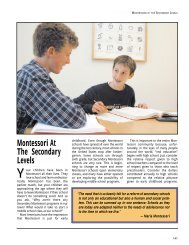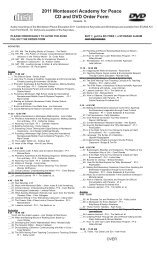Tim Seldin & Paul Epstein Ph.D. An Education for Life
Tim Seldin & Paul Epstein Ph.D. An Education for Life
Tim Seldin & Paul Epstein Ph.D. An Education for Life
Create successful ePaper yourself
Turn your PDF publications into a flip-book with our unique Google optimized e-Paper software.
THE MONTESSORI WAY<br />
10<br />
My educational method has grown from these,<br />
as well as from many other revelations, given by<br />
the children. You know, from what I have told<br />
you, that all the details included in the method<br />
have come from the ef<strong>for</strong>ts to follow the child.<br />
The new path has been shown us. No one knows<br />
exactly how it arose; it just came into being and<br />
showed us the new way.<br />
It has nothing to do with any educational<br />
method of the past nor with any educational<br />
method of the future. It stands alone as the<br />
contribution of the child himself. Perhaps it is the<br />
first of its kind, which has been built by him, step<br />
by step.<br />
It cannot have come from an adult person; the<br />
thought, the very principle that the adult should<br />
stand aside to make room <strong>for</strong> the child, could<br />
never have come from the adult.<br />
<strong>An</strong>yone who wants to follow my method must<br />
understand that he should not honor me, but follow<br />
the child as his leader.”<br />
Maria Montessori discovered that when<br />
young children concentrate and investigate a<br />
set of purposefully designed activities, they<br />
tend to develop self-control; their movements<br />
become ordered, and they appear<br />
peaceful. Their demeanor towards others<br />
becomes kind and gentle.<br />
These characteristics and other discoveries<br />
made with the children of San Lorenzo in<br />
1907 were quickly replicated, as new<br />
Montessori schools opened throughout<br />
Europe and around the world. Children in<br />
Elementary and Secondary Montessori<br />
schools displayed tremendous enthusiasm as<br />
they explored and studied topics in great<br />
detail. Their learning achievements were profound.<br />
The overall Montessori experience,<br />
however, is deeper than an academic course<br />
of study. Because the Montessori process fully<br />
engages children’s natural learning potentials,<br />
Montessori students learn about themselves,<br />
develop self-confidence, communicate<br />
effectively, and work well in groups.<br />
Today’s Montessori schools incorporate the<br />
discoveries of Maria Montessori as well as<br />
recent understandings of how learning and<br />
development take place. Montessori schools<br />
are now found in private, public, and homeschool<br />
settings in the United States and<br />
abroad. The educational programs located in<br />
these schools range from infant care to<br />
high school students.<br />
Many of these schools are affiliates of,<br />
or are accredited by, one of a dozen national<br />
and/or international Montessori organizations.<br />
Teachers receive Montessori teacher certification<br />
after completing rigorous courses of<br />
study. Many teachers describe their own experiences<br />
of personal trans<strong>for</strong>mation as they,<br />
too, witness in children astounding capabilities.<br />
From a family’s perspective, becoming<br />
part of a Montessori school could be thought<br />
of as adopting a natural lifestyle we call The<br />
Montessori Way.<br />
(Below) Students at the Montessori School in the Convent of<br />
the Franciscan Nuns, Rome, c. 1912.




